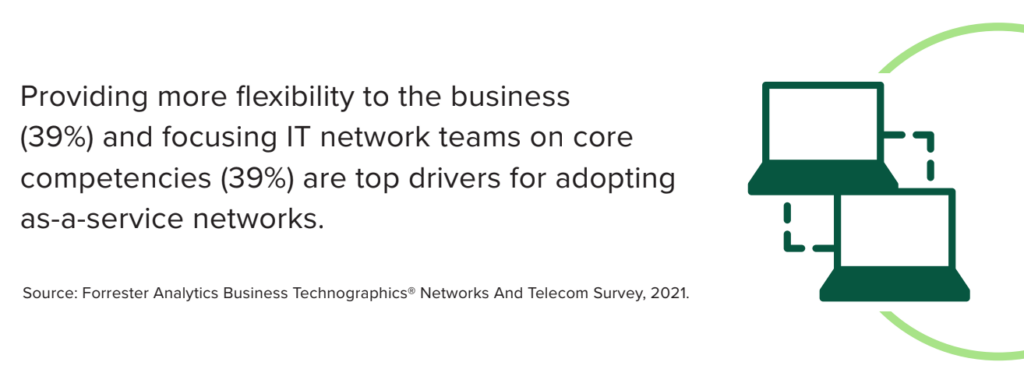
Five Features Your Enterprise Network Needs in 2023
- December 12, 2022
We reflect on the standout criteria that defined optimal enterprise cloud connectivity this year, and share how you can set up your network for success in 2023.
In 2022, Megaport published the Forrester 2022 Cloud Connectivity Buyer’s Guide , a comprehensive assessment of enterprise cloud connectivity needs. Commissioned by Megaport and using findings by Forrester Consulting, the guide aims to provide operational insights for IT decision-makers to evaluate their enterprise cloud connectivity choices and advise when it makes sense to use software-defined networking (SDN).
The guide identified five key attributes to look for when searching for appropriate cloud connectivity infrastructure:
- Performance, speed, and availability;
- Scalability and elasticity;
- Simple provisioning and upgrade;
- Automation and orchestration; and
- Intrinsic security and privacy.
The growing reliance on cloud-based technologies, paired with the rising usage of hybrid cloud and multicloud infrastructures in support of business-critical applications, means it’s never been more crucial for organizations to modernize their cloud connectivity strategy.
Plus, as the global economy evolves post-pandemic, enterprises will require high-performance technologies to support employees who are working remotely to remain competitive. These findings should serve as a checklist that enterprises can use going in to 2023 to develop their enterprise cloud migration and network optimization strategies for the year ahead.
Contents
- Performance, speed, and availability
- Scalability and elasticity
- Simple provisioning and upgrading
- Automation and orchestration
- Intrinsic security and privacy
- Summary
1. Performance, speed, and availability
Forrester’s recommended selection criteria
According to Forrester, getting better performance by using or increasing as-a-service networking is key for 40% of decision-makers. As services stretch across different clouds and geographies, not only does network traffic greatly expand – service quality also increasingly depends on the quality of connections between components of the service.
It is then crucial that global enterprises look for a solution that promotes top network performance not only for better employee experience, but also customer experience. Without the right connectivity between clouds, networks can be slow and unreliable, consuming excessive bandwidth and becoming prone to higher latency.

The Buyer’s Guide recommends that to improve network performance and speed, look for solutions that privately peer between all major cloud platforms and provide you the maximum in-cloud meshing capabilities. Enterprises should also opt for solutions that use network virtualization and SDN to reduce hairpinning and avoid reliance on data centers or on-premises infrastructure, which in turn can increase your network speeds.
How Megaport can help
Megaport’s private connectivity allows you to directly connect to multiple clouds reliably, with lower risk of spikes in demand impacting your network capabilities. As Megaport connections don’t rely on the unsecure public internet (as well as its traffic), your business can expect predictable performance including lower latency , reduced hops, and faster speeds. This means your enterprise can continue business as usual, without painful interruptions for your employees or customers. What’s more, Megaport allows for private peering across your clouds , and can assist in reducing hairpinning in your cloud infrastructure.

Learn more in our blog, ‘Optimizing Performance and Cost With Private Connectivity’.
2. Scalability and elasticity
Forrester’s recommended selection criteria
It’s crucial for every enterprise to have a network that can adapt with their changing priorities and demands. That’s why Forrester recommends that IT decision-makers look for cloud solutions that support scalability through dynamic network capacity. The Buyer’s Guide suggests that you look for on-demand solutions that offer scalable bandwidth and a transparent pay-as-you-use billing model. This means your business is free from vendor lock-in, and can change your network infrastructure as your business needs (whether it’s adding locations or reducing bandwidth requirements).
By choosing a simple Network as a Service (NaaS) operating model, enterprises can pay only for what they use, and disregard the features they won’t need – as well as leave the possession and maintenance of infrastructure to the experts. The Buyer’s Guide suggests looking for providers that allow you to use their network to connect to infrastructure in any facility attached to the network: This includes not only cloud providers but also colocation facilities, owned data centers, and edge locations such as branch offices. Additionally, enterprises should consider solutions that can work with existing network investments to ease the strain on budget woes.

How Megaport can help
Megaport’s NaaS operates through a pay-as-you-go billing model, meaning you can hit pause and play should you need. As part of your agreement, you can scale connectivity and speeds up and down as you need . This also means your business can remain elastic to changing needs and priorities – whether it’s requiring quicker speeds, or scaling down bandwidth for certain locations.
The capacity to spin up connections on-demand means you can optimize your bandwidth levels and be agile in how you use your network: This is only possible with virtualized private interconnection.
3. Simple provisioning and upgrading
Forrester’s recommended selection criteria
Forrester found that 39% of respondents listed providing more flexibility to the business as one of their top drivers for adopting as-a-service networks. In response, the Buyer’s Guide recommends that enterprises look for fully programmable solutions with self-service capabilities (e.g. management by workload, the ability to apply policy, traffic control, and intelligent routing) to accelerate deployment and provisioning, and reduce the time spent by network administrators on planning and provisioning, as well as researching connectivity and service provider options.
IT decision-makers should select a solution that automates connectivity provisioning and configurations, as well as allows for plan upgrades, via both an easy-to-use portal or open APIs. Cloud solutions should be data center-neutral and highly distributed, while also offering SD-WAN-enabled interconnection.

How Megaport can help
When using a virtual cloud router like Megaport Cloud Router (MCR) , intercloud connections are easy to set up: Simply deploy a Virtual Cross Connect (VXC) via the Megaport portal to connect your clouds in minutes, and extend the on-demand cost benefits of your NaaS setup across your multicloud.
By using NaaS for your cloud service provider (CSP) connectivity, you’re investing in easier provisioning for your business for years to come, as well as enabling your network architecture to easily change and expand as needed. With our simple “point, click, connect” setup, customers can turn up connections in seconds and pay only for bandwidth consumed, thereby always controlling and maximizing spend as cost resilience becomes a natural and expected feature of your business.
Customers can also deploy SD-WAN gateways, virtual routers, and integrated transit gateways in minutes, allowing for simple provisioning and upgrading to networks . And with Megaport’s open APIs , provisioning connectivity to your various cloud deployment can be easier than ever.
4. Automation and orchestration
Forrester’s recommended selection criteria
Forrester believes that ultimately, the entire enterprise network will need to be automated and orchestrated – however, it’s unrealistic to expect one solution to control your business fabric: Sections of networks or services will come from various parties, including carriers. That’s why you should look for solutions that offer open APIs and adapters between different controllers, orchestrators, and managers. Used in conjunction with other automation and continuous delivery processes – such as agile development, DevOps, and DevSecOps – as-a-service cloud offerings can drive up release velocity and innovation cycles.
Look for cloud solutions that offer on-demand capacity, auto-scaling, and pay-as-you-consume economics, all of which can be pre-defined, scripted, and provisioned via simple-to-use portals or API calls. This will ultimately help realize a Virtual Network Infrastructure (VNI) vision.

How Megaport can help
Megaport’s NaaS enables task automation through APIs for better productivity, which reduces resource costs and improves your business’ scalability so you only pay for what you use. Acting as a midpoint between you and your CSPs, you can apply automation or APIs to streamline the process across your entire network.

Learn how to automate and orchestrate your network in our blog.
5. Intrinsic security and privacy
Forrester’s recommended selection criteria
Forrester found that 27% of IT decision-makers reported security concerns in deploying and using multiple cloud platforms and environments. But with multicloud infrastructure now the standard for any competitive business, enterprises need to look for solutions that provide the benefits of multicloud while remaining secure. The Buyer’s Guide, then, recommends you avoid relying on the public internet, which, while being a cost-effective means to accessing multiple clouds simultaneously, can pose a data security threat. Instead, opt for private connectivity.
Organizations need to not only validate the security posture of their cloud providers’ environments (security in the cloud) but also provide a way of securely connecting to cloud services and infrastructure (security to the cloud). Dedicated, private connections solve this concern. Finally, look for solutions that enable local connections to country-compliant cloud on-ramps that achieve data sovereignty requirements.

How Megaport can help
Megaport’s NaaS is a private cloud network layer that enables users to operate a network without having to own, build, or maintain any infrastructure – and without using the public internet. By avoiding the public internet—which can pose a threat to your enterprise through greater exposure to cyberattacks (as we detail in our blog, Is Your Internet Connection Damaging Your Business? )—your business can rest assured that mission-critical data will be protected. Acting similarly to a private road, Megaport services route your mission-critical traffic to Megaport’s private SDN, then to the major cloud providers.

Learn more about why you need integrated network security for your business.
Summary
Forrester’s recommended selection criteria
Noting that a sophisticated network is no longer just a commodity but rather “the fabric of digital business,” Forrester provided insightful guidance on key focus areas that every organization should consider when modernizing their cloud connectivity solutions. Forrester’s recommendations can be summarized by stating that a modern cloud connectivity solution for your enterprise must effectively support simple upgrading and automation, while maintaining top performance as well as remaining secure.
Decision-makers should evaluate providers based on peering locations, edge connectivity options, required bandwidth, and accessibility of additional resources. The flexibility organizations will gain from this type of approach will allow them to make business decisions quickly, and be able to act on them at cloud speed.
How Megaport can help
Megaport agrees with Forrester on these tenets for a modern approach to cloud connectivity and network. Megaport delivers capabilities that align with each of Forrester’s five recommendations through our NaaS offering, and enable organizations to achieve unparalleled network performance and speed, scale connections up and down, easily upgrade their service, automate and orchestrate their processes, and bolster their network security across data centers, at the edge, and in the cloud.
Download the complete Forrester 2022 Cloud Connectivity Buyer’s Guide now .
Source: A Forrester Consulting Thought Leadership Paper Spotlight commissioned by Megaport, April 2022.


